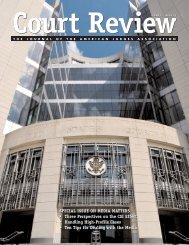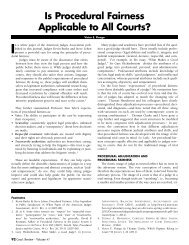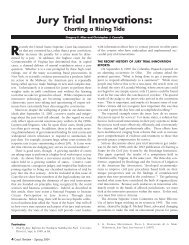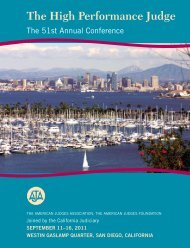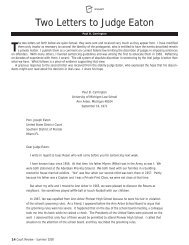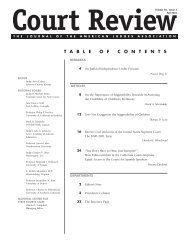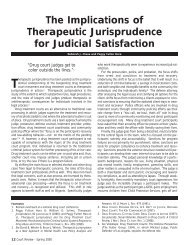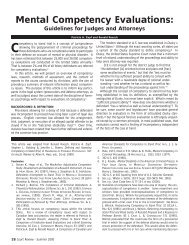Special Issue on Procedural Fairness - American Judges Association
Special Issue on Procedural Fairness - American Judges Association
Special Issue on Procedural Fairness - American Judges Association
- No tags were found...
You also want an ePaper? Increase the reach of your titles
YUMPU automatically turns print PDFs into web optimized ePapers that Google loves.
courts are based heavily up<strong>on</strong> evaluati<strong>on</strong>s of the fairness ofcourt procedures. 16 In particular, people are found to be sensitiveto whether the courts protect their rights and to whetherthey think that judges are h<strong>on</strong>est. While these procedural justicejudgments are the most important factor shaping trust andc<strong>on</strong>fidence in the courts, those interviewed are also sensitive towhether the courts treated the members of different groupsequally, as well as to other structural issues about the courts,such as cost and delay. But, their primary basis for evaluati<strong>on</strong>is procedural justice.The str<strong>on</strong>g linkage between procedural justice and evaluati<strong>on</strong>sof the courts was recent affirmed by a study c<strong>on</strong>ductedwithin the State Courts of California. The AdministrativeOffice of the Courts undertook a study in 2005 in which a randomsample of the residents of the state were interviewedabout their trust and c<strong>on</strong>fidence in the California courts. Ananalysis of that informati<strong>on</strong> 17 suggests that “[h]aving a sensethat court decisi<strong>on</strong>s are made through processes that are fair isthe str<strong>on</strong>gest predictor by far of whether members of the publicapprove of or have c<strong>on</strong>fidence in the California courts.” 18The California courts are rated as being very fair in terms oftreating people with dignity and respect, but as not particularlyfair in terms of allowing them to participate in decisi<strong>on</strong>s thataffect them. The report argues that “[p]olicies that promoteprocedural fairness offer the vehicle with the greatest potentialfor changing how the public views the state courts.” 19Interestingly, the report points to experiences with lowstakescourts, such as traffic court, as a particular source of dissatisfacti<strong>on</strong>,and argues that all experiences with legal authorities,even relatively trivial interacti<strong>on</strong>s, are important to membersof the public and need to be the focus of court designefforts. Finally, the report argues that there need to be mechanismsfor the <strong>on</strong>going evaluati<strong>on</strong> of people’s experiences withthe courts, mechanisms instituti<strong>on</strong>alized through periodic surveysof members of the public, especially those who have hadexperiences with the courts.One reas<strong>on</strong> that these findings are particularly important isthat they provide an independent c<strong>on</strong>firmati<strong>on</strong> that issues ofprocedural justice matter in real court settings. This study wasnot c<strong>on</strong>ducted or evaluated by the academic researchers whohave been resp<strong>on</strong>sible for many of the early studies of proceduraljustice. Instead, theneed for this study arosewithin the framework of courtc<strong>on</strong>cerns in California; thestudy was designed and c<strong>on</strong>ductedwithin the frameworkof the administrative offices ofthe courts; and the report waswritten by David Rottman, aresearcher at the Nati<strong>on</strong>alCenter for State Courts.The proceduraljustice researchfindings "alsoapply to thepeople who workwithin the courtsystem."Hence, the c<strong>on</strong>firmati<strong>on</strong> of core procedural justice findings isespecially important.Similar c<strong>on</strong>clusi<strong>on</strong>s have also been reached by other judicialleaders. The White Paper <strong>on</strong> procedural fairness authored by<strong>Judges</strong> Kevin Burke and Steve Leben, 20 presented at the annualmeeting of the <strong>American</strong> <strong>Judges</strong> Associati<strong>on</strong> in 2007 andwhich is the focus of this special issue of Court Review, isanother example. The White Paper reviews research <strong>on</strong> proceduraljustice, including recent studies c<strong>on</strong>ducted within thecourt systems of Hennepin County, Minnesota, under JudgeBurke’s directi<strong>on</strong>, and in Brooklyn, New York. 21 Again, thesecourt-designed and sp<strong>on</strong>sored evaluati<strong>on</strong>s point to the importanceof procedural justice in encouraging satisfacti<strong>on</strong>, decisi<strong>on</strong>acceptance, and trust and c<strong>on</strong>fidence in the courts. 22Finally, the findings outlined do not apply <strong>on</strong>ly to litigantsor other members of the public who come to court (the“clients” of the court system). They also apply to the peoplewho work within the court system. Studies of employees ingeneral indicate that employees in a wide variety of types ofwork organizati<strong>on</strong> evaluate their own experiences <strong>on</strong> the job interms of the procedural fairness of their treatment by their ownauthorities. Research suggests that the degree to whichemployees follow work rules, as well as doing their jobs well,is linked to the fairness of workplace procedures. 23 Similarly,studies of agents of social c<strong>on</strong>trol, for example police officers,suggest that their behavior <strong>on</strong> the job is related to how fairlythey are treated by their supervisors. 24 Hence, the same principlesthat can be used to design efforts to deal with the publicalso apply to efforts to design effective approaches to dealingwith the people working within the criminal justice system.16. Tom R. Tyler, Public Trust and C<strong>on</strong>fidence in Legal Authorities:What Do Majority and Minority Group Members Want for the Lawand Legal Instituti<strong>on</strong>s? 19 BEHAV. SCI. & L. 215 (2001).17. ROTTMAN, TRUST AND CONFIDENCE, supra note 15.18. Id. at 6.19. Id. at 7.20. <strong>Procedural</strong> <strong>Fairness</strong>: A Key Ingredient in Public Satisfacti<strong>on</strong>, 44 CT.REV. 4 (this issue) (White Paper originally delivered at the annualc<strong>on</strong>ference of the <strong>American</strong> <strong>Judges</strong> Associati<strong>on</strong>, Sept. 2007,Vancouver, B.C.), available at http://aja.ncsc.dni.us/htdocs/AJAWhitePaper9-26-07.pdf.21. M. SOMJEN FRAZER, THE IMPACT OF THE COMMUNITY COURT MODEL INDEFENDANT PERCEPTIONS OF FAIRNESS: A CASE STUDY AT THE REDHOOK COMMUNITY JUSTICE CENTER (2006), available athttp://courtinnovati<strong>on</strong>.org/_uploads/documents/<strong>Procedural</strong>_<strong>Fairness</strong>.pdf.22. See M. Somjen Fraser, Examining Defendant Percepti<strong>on</strong>s of <strong>Fairness</strong>in the Courtroom, 91 JUDICATURE 36 (2007); Making EveryEncounter Count: Building Trust and C<strong>on</strong>fidence in the Police, NAT’LINST. JUST. J., Jan. 2007, at 8, available at http://www.ncjrs.gov/pdffiles1/nij/jr000256c.pdf.23. Tom R. Tyler, Promoting Employee Policy Adherence and RuleFollowing in Work Settings: The Value of Self-regulatory Approaches,70 BROOK. L. REV. 1287 (2005); Tom R Tyler & Steven L. Blader,Can Businesses Effectively Regulate Employee C<strong>on</strong>duct?: TheAntecedents of Rule Following in Work Settings, 48 ACAD. MGMT. J.1143 (2005).24. Tom R. Tyler, Patrick E. Callahan & Jeffrey Frost, Armed, andDangerous(?): Motivating Rule Adherence Am<strong>on</strong>g Agents of SocialC<strong>on</strong>trol, 41 L. & SOC’Y REV. 457 (2007).Court Review - Volume 44 29



